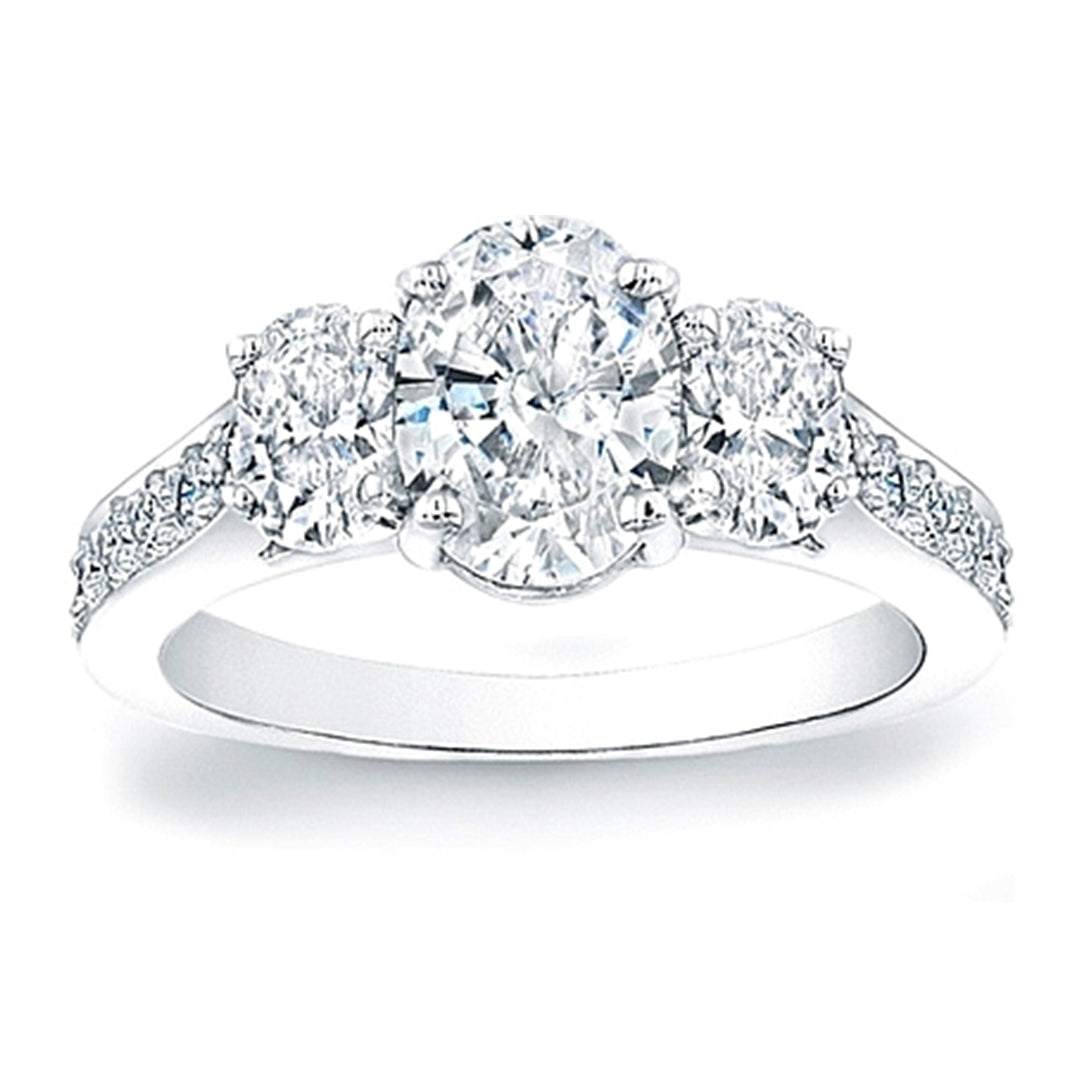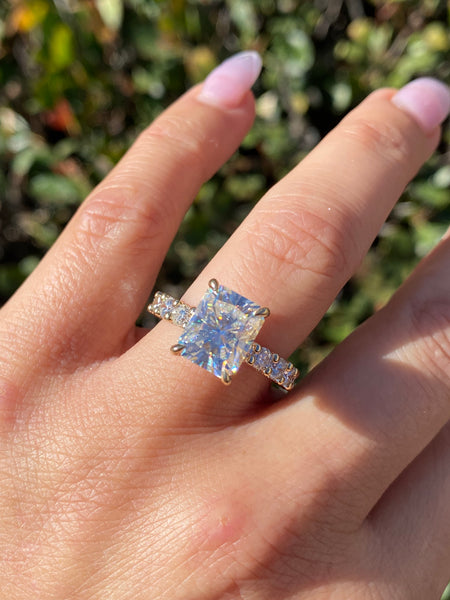Why Laboratory Grown Diamond Engagement Rings Are the Perfect Choice for Eco-Conscious Couples
Lab-grown Diamond involvement rings provide a compelling choice for couples who prioritize sustainability. These rubies offer a striking option to traditional extracted rocks, substantially decreasing environmental injury. They are created making use of advanced techniques that ensure both top quality and brilliance. As awareness of ethical sourcing grows, several couples are reassessing their options. What ramifications does this shift have for the future of the Diamond industry?

The Ecological Impact of Standard Diamond Mining
Diamond mining has long been commemorated for its attraction and status, the ecological repercussions of typical mining methods are progressively concerning. The extraction of rubies typically involves substantial land interruption, leading to deforestation and environment loss for plenty of types. In addition, the process takes in vast amounts of water, which can diminish local sources and adversely affect bordering areas. Hazardous chemicals used in mining procedures can infect neighboring water sources, additionally jeopardizing both human populations and wild animals.
Furthermore, the carbon footprint related to transferring extracted rubies adds to the general environmental toll. The hefty equipment and devices needed for mining operations add considerably to greenhouse gas emissions. As understanding of these problems expands, numerous consumers are beginning to wonder about the sustainability of typical Diamond sourcing. This change in viewpoint highlights the urgent need for even more ecologically friendly options, such as lab-grown rubies, which guarantee to decrease the environmental influence while maintaining the beauty and value of Diamond jewelry.
The Process of Creating Lab-Grown Diamonds
Lab-grown diamonds are produced through 2 main approaches: High Stress High Temperature Level (HPHT) and Chemical Vapor Deposition (CVD) The HPHT procedure resembles the all-natural problems under which diamonds develop in the Earth's mantle. It includes subjecting carbon to extreme pressure and temperature level, causing the condensation of carbon atoms right into Diamond frameworks. In contrast, the CVD technique enables the development of diamonds in a controlled setting. This technique utilizes a gas combination containing carbon, which is energized to form plasma, allowing carbon atoms to down payment onto a substrate and expand layer by layer right into Diamond crystals.
Both techniques create diamonds that are chemically and physically identical to all-natural diamonds - lab grown diamond engagement rings. The option of method usually relies on the wanted features and dimension of the last gem. This cutting-edge strategy to Diamond production not only uses a lasting choice yet also enables better transparency in the sourcing of materials
Quality and Brilliance of Lab-Grown Diamonds
While several might think that lab-grown diamonds differ in quality from their natural equivalents, they actually display similar radiance and visual allure. Lab-grown diamonds are produced utilizing sophisticated technology that reproduces the natural conditions under which rubies create, resulting in rocks that possess identical physical and chemical residential or commercial properties. These rubies attain the very same phenomenal clearness and color grading as mined diamonds, making them equivalent to the nude eye.
In terms of radiance, lab-grown rubies commonly present premium light performance because of their precision-cut facets. The strenuous quality assurance throughout production assurances that these diamonds meet high standards, boosting their visual appeal. Additionally, they are offered in a range of sizes and forms, enabling pairs to discover the ideal ring to match their individual design. Inevitably, lab-grown diamonds provide a beautiful combination of charm and high quality, making them an enticing option for interaction rings.
Moral Considerations in the Diamond Sector
As customers end up being progressively familiar with the moral effects surrounding Diamond sourcing, the discussion around the Diamond market has shifted substantially. Worries regarding problem diamonds, often referred to as "blood rubies," have triggered require higher transparency and liability in mining methods. These rubies are mined in battle areas and marketed to finance armed problem, elevating severe moral inquiries for customers. Additionally, the environmental influence of conventional Diamond mining has actually come under examination, with issues such as environment devastation and water contamination regularly highlighted.
In reaction, lots of have transformed to lab-grown rubies as a much more honest choice. These stones are developed in controlled atmospheres, eliminating the dangers connected with mining. Lab-grown diamonds appeal to customers seeking to make liable choices that align with their values. The expanding need for honest techniques remains to reshape the Diamond sector, promoting gentle and sustainable sourcing approaches.
Cost-Effectiveness of Lab-Grown Diamonds
Lab-grown rubies offer a compelling alternative for customers looking for cost-efficient involvement rings - lab grown diamond engagement rings. Valued considerably lower than their natural equivalents, they provide outstanding worth for money without giving up high quality or appearance. This affordability makes lab-grown diamonds an attractive alternative for budget-conscious pairs
Reduced Rate Factor
Numerous couples are discovering that choosing lab-grown Diamond interaction rings can significantly decrease their total expenses without giving up top quality or beauty. These diamonds usually cost 30% to 50% less than their extracted counterparts, making them an eye-catching option for budget-conscious consumers. The rate benefit develops from reduced manufacturing costs and a much more efficient supply chain, which removes the expenses associated with mining. Because of this, couples can buy bigger rocks or even more detailed setups, boosting the overall visual of their rings. This affordability not only permits an extra tailored option but additionally straightens with the worths of eco-conscious couples that prioritize sustainability while staying financially savvy. Lab-grown rubies give a perfect mix of beauty and economic climate.
Value for Money
The cost-effectiveness of lab-grown rubies prolongs beyond their preliminary price, using phenomenal value for cash. Unlike natural rubies, lab-grown options can be approximately 40% less costly while preserving the exact same physical and chemical homes. This price enables pairs to buy bigger or higher-quality rocks without surpassing their budgets. In addition, the resale value of lab-grown rubies is slowly enhancing, making them an extra sensible choice for future economic factors to consider. Furthermore, lab-grown rubies usually come with reduced ethical and environmental costs, supplying pairs with comfort. By picking lab-grown rubies, eco-conscious pairs not only conserve anchor money however also add to lasting practices, improving their total worth recommendation in the fashion jewelry market.

Customization Options for Lab-Grown Engagement Rings
Exactly how can pairs ensure their involvement ring shows their unique romance? Customization alternatives for lab-grown Diamond engagement rings offer an optimal solution. Couples can pick from numerous Diamond forms, including round, princess, or oval, allowing them to select a design that find out this here reverberates with their personal aesthetic.
Furthermore, they can select the setup-- be it solitaire, halo, or vintage-inspired-- making certain the ring matches the Diamond's luster. Steel selections, such as white gold, yellow gold, or increased gold, additionally improve personalization, dealing with individual preferences.
Pairs can include significant inscriptions, adding a sentimental touch that represents their bond. With these substantial modification alternatives, lab-grown Diamond engagement rings not only symbolize a pair's love but likewise mirror their values, making them a perfect choice for eco-conscious collaborations. Eventually, these rings become a true representation of their special trip together.
Frequently Asked Inquiries
How Do Lab-Grown Diamonds Compare to Natural Diamonds in Value?
Lab-grown diamonds generally set you back 20-40% much less than natural diamonds, using comparable high quality and appearance. Their reduced rate point makes them an enticing alternative, particularly for budget-conscious consumers looking for lasting and honest choices in precious jewelry.

Are Lab-Grown Diamonds More Resilient Than Natural Diamonds?
Lab-grown rubies have the exact same physical and chemical residential or commercial properties as natural diamonds, consisting of go to this web-site durability. Both kinds score an excellent 10 on the Mohs scale, ensuring that lab-grown diamonds are equally resistant to scratching and damage.
Can Lab-Grown Diamonds Be Re-selled Easily?
Lab-grown diamonds can be re-selled, however their market need varies compared to all-natural rubies. While some purchasers appreciate their ethical origins, others might like natural alternatives, potentially impacting resale worth and ease of deal.
What Are the Treatment Recommendations for Lab-Grown Diamonds?
Lab-grown rubies require regular like preserve their sparkle. Cleaning up with moderate soap and cozy water, making use of a soft brush, and preventing rough chemicals will assist preserve their shimmer and integrity for several years to come.
Exist Any Qualifications for Lab-Grown Diamonds?
Lab-grown diamonds can be certified by reputable organizations such as the Gemological Institute of America (GIA) and the International Gemological Institute (IGI) These certifications assure authenticity, adherence, and high quality to industry standards for lab-created gemstones.
Both techniques generate rubies that are chemically and literally the same to all-natural diamonds. Lab-grown rubies are created making use of advanced technology that reproduces the all-natural conditions under which rubies develop, resulting in stones that have similar physical and chemical properties. Lab-grown rubies normally cost 20-40% much less than all-natural rubies, offering comparable high quality and appearance. Lab-grown rubies have the very same physical and chemical homes as all-natural rubies, including longevity. Lab-grown diamonds can be re-selled, but their market demand differs compared to all-natural rubies.